[English] 日本語
 Yorodumi
Yorodumi- PDB-8tyc: Lassa GPC (strain Josiah) bound to rabbit polyclonal base-targeti... -
+ Open data
Open data
- Basic information
Basic information
| Entry | Database: PDB / ID: 8tyc | |||||||||||||||
|---|---|---|---|---|---|---|---|---|---|---|---|---|---|---|---|---|
| Title | Lassa GPC (strain Josiah) bound to rabbit polyclonal base-targeting antibody Base-1 | |||||||||||||||
 Components Components |
| |||||||||||||||
 Keywords Keywords | VIRAL PROTEIN/IMMUNE SYSTEM / Lassa virus glycoprotein complex / GPC / immune complex / antibody / polyclonal antibody / base antibody / VIRAL PROTEIN / VIRAL PROTEIN-IMMUNE SYSTEM complex | |||||||||||||||
| Function / homology |  Function and homology information Function and homology informationD-galactonate catabolic process / 2-dehydro-3-deoxy-6-phosphogalactonate aldolase activity / host cell Golgi membrane / receptor-mediated endocytosis of virus by host cell / host cell endoplasmic reticulum membrane / fusion of virus membrane with host endosome membrane / viral envelope / virion attachment to host cell / host cell plasma membrane / virion membrane ...D-galactonate catabolic process / 2-dehydro-3-deoxy-6-phosphogalactonate aldolase activity / host cell Golgi membrane / receptor-mediated endocytosis of virus by host cell / host cell endoplasmic reticulum membrane / fusion of virus membrane with host endosome membrane / viral envelope / virion attachment to host cell / host cell plasma membrane / virion membrane / metal ion binding / membrane Similarity search - Function | |||||||||||||||
| Biological species |  Lassa virus Lassa virus  Thermotoga maritima (bacteria) Thermotoga maritima (bacteria) | |||||||||||||||
| Method | ELECTRON MICROSCOPY / single particle reconstruction / cryo EM / Resolution: 3.3 Å | |||||||||||||||
 Authors Authors | Perrett, H.R. / Brouwer, P.J.M. / Ward, A.B. | |||||||||||||||
| Funding support |  United States, United States,  Netherlands, 4items Netherlands, 4items
| |||||||||||||||
 Citation Citation |  Journal: Cell Rep / Year: 2024 Journal: Cell Rep / Year: 2024Title: Defining bottlenecks and opportunities for Lassa virus neutralization by structural profiling of vaccine-induced polyclonal antibody responses. Authors: Philip J M Brouwer / Hailee R Perrett / Tim Beaumont / Haye Nijhuis / Sabine Kruijer / Judith A Burger / Ilja Bontjer / Wen-Hsin Lee / James A Ferguson / Martin Schauflinger / Helena Müller- ...Authors: Philip J M Brouwer / Hailee R Perrett / Tim Beaumont / Haye Nijhuis / Sabine Kruijer / Judith A Burger / Ilja Bontjer / Wen-Hsin Lee / James A Ferguson / Martin Schauflinger / Helena Müller-Kräuter / Rogier W Sanders / Thomas Strecker / Marit J van Gils / Andrew B Ward /    Abstract: Lassa fever continues to be a major public health burden in West Africa, yet effective therapies or vaccines are lacking. The isolation of protective neutralizing antibodies against the Lassa virus ...Lassa fever continues to be a major public health burden in West Africa, yet effective therapies or vaccines are lacking. The isolation of protective neutralizing antibodies against the Lassa virus glycoprotein complex (GPC) justifies the development of vaccines that can elicit strong neutralizing antibody responses. However, Lassa vaccine candidates have generally been unsuccessful at doing so, and the associated antibody responses to these vaccines remain poorly characterized. Here, we establish an electron microscopy-based epitope mapping workflow that enables high-resolution structural characterization of polyclonal antibodies to the GPC. By applying this method to rabbits vaccinated with a recombinant GPC vaccine and a GPC-derived virus-like particle, we reveal determinants of neutralization that involve epitopes of the GPC-A competition cluster. Furthermore, by identifying undescribed immunogenic off-target epitopes, we expose the challenges that recombinant GPC vaccines face. By enabling detailed polyclonal antibody characterization, our work ushers in a next generation of more rational Lassa vaccine design. | |||||||||||||||
| History |
|
- Structure visualization
Structure visualization
| Structure viewer | Molecule:  Molmil Molmil Jmol/JSmol Jmol/JSmol |
|---|
- Downloads & links
Downloads & links
- Download
Download
| PDBx/mmCIF format |  8tyc.cif.gz 8tyc.cif.gz | 285.5 KB | Display |  PDBx/mmCIF format PDBx/mmCIF format |
|---|---|---|---|---|
| PDB format |  pdb8tyc.ent.gz pdb8tyc.ent.gz | 227.8 KB | Display |  PDB format PDB format |
| PDBx/mmJSON format |  8tyc.json.gz 8tyc.json.gz | Tree view |  PDBx/mmJSON format PDBx/mmJSON format | |
| Others |  Other downloads Other downloads |
-Validation report
| Summary document |  8tyc_validation.pdf.gz 8tyc_validation.pdf.gz | 3.4 MB | Display |  wwPDB validaton report wwPDB validaton report |
|---|---|---|---|---|
| Full document |  8tyc_full_validation.pdf.gz 8tyc_full_validation.pdf.gz | 3.4 MB | Display | |
| Data in XML |  8tyc_validation.xml.gz 8tyc_validation.xml.gz | 54.5 KB | Display | |
| Data in CIF |  8tyc_validation.cif.gz 8tyc_validation.cif.gz | 80.4 KB | Display | |
| Arichive directory |  https://data.pdbj.org/pub/pdb/validation_reports/ty/8tyc https://data.pdbj.org/pub/pdb/validation_reports/ty/8tyc ftp://data.pdbj.org/pub/pdb/validation_reports/ty/8tyc ftp://data.pdbj.org/pub/pdb/validation_reports/ty/8tyc | HTTPS FTP |
-Related structure data
| Related structure data |  41713MC  8tyeC 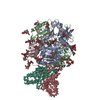 8vcvC 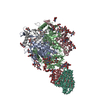 8ve8C 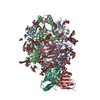 9cj7C 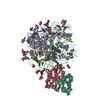 9cj8C 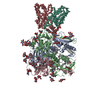 9ck7C  9ck8C M: map data used to model this data C: citing same article ( |
|---|---|
| Similar structure data | Similarity search - Function & homology  F&H Search F&H Search |
- Links
Links
- Assembly
Assembly
| Deposited unit | 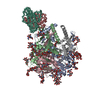
|
|---|---|
| 1 |
|
- Components
Components
-Glycoprotein ... , 2 types, 6 molecules ABCabc
| #1: Protein | Mass: 29010.352 Da / Num. of mol.: 3 Source method: isolated from a genetically manipulated source Source: (gene. exp.)  Lassa virus / Strain: Mouse/Sierra Leone/Josiah/1976 / Gene: GPC / Production host: Lassa virus / Strain: Mouse/Sierra Leone/Josiah/1976 / Gene: GPC / Production host:  Homo sapiens (human) / References: UniProt: P08669 Homo sapiens (human) / References: UniProt: P08669#4: Protein | Mass: 44765.047 Da / Num. of mol.: 3 Source method: isolated from a genetically manipulated source Source: (gene. exp.)  Lassa virus, (gene. exp.) Lassa virus, (gene. exp.)   Thermotoga maritima (strain ATCC 43589 / DSM 3109 / JCM 10099 / NBRC 100826 / MSB8) (bacteria) Thermotoga maritima (strain ATCC 43589 / DSM 3109 / JCM 10099 / NBRC 100826 / MSB8) (bacteria)Strain: Mouse/Sierra Leone/Josiah/1976, ATCC 43589 / DSM 3109 / JCM 10099 / NBRC 100826 / MSB8 Gene: GPC, GP-C, TM_0066 / Production host:  Homo sapiens (human) / References: UniProt: P08669, UniProt: Q9WXS1 Homo sapiens (human) / References: UniProt: P08669, UniProt: Q9WXS1 |
|---|
-Antibody , 2 types, 2 molecules HL
| #2: Antibody | Mass: 9209.344 Da / Num. of mol.: 1 / Source method: isolated from a natural source / Source: (natural)  |
|---|---|
| #3: Antibody | Mass: 9124.238 Da / Num. of mol.: 1 / Source method: isolated from a natural source / Source: (natural)  |
-Sugars , 6 types, 33 molecules 
| #5: Polysaccharide | 2-acetamido-2-deoxy-beta-D-glucopyranose-(1-4)-2-acetamido-2-deoxy-beta-D-glucopyranose Source method: isolated from a genetically manipulated source #6: Polysaccharide | beta-D-mannopyranose-(1-4)-2-acetamido-2-deoxy-beta-D-glucopyranose-(1-4)-2-acetamido-2-deoxy-beta- ...beta-D-mannopyranose-(1-4)-2-acetamido-2-deoxy-beta-D-glucopyranose-(1-4)-2-acetamido-2-deoxy-beta-D-glucopyranose Source method: isolated from a genetically manipulated source #7: Polysaccharide | alpha-L-fucopyranose-(1-3)-2-acetamido-2-deoxy-beta-D-glucopyranose | Source method: isolated from a genetically manipulated source #8: Polysaccharide | 2-acetamido-2-deoxy-beta-D-glucopyranose-(1-4)-[alpha-L-fucopyranose-(1-6)]2-acetamido-2-deoxy-beta- ...2-acetamido-2-deoxy-beta-D-glucopyranose-(1-4)-[alpha-L-fucopyranose-(1-6)]2-acetamido-2-deoxy-beta-D-glucopyranose | Source method: isolated from a genetically manipulated source #9: Polysaccharide | Source method: isolated from a genetically manipulated source #10: Sugar | ChemComp-NAG / |
|---|
-Details
| Has ligand of interest | N |
|---|---|
| Has protein modification | Y |
-Experimental details
-Experiment
| Experiment | Method: ELECTRON MICROSCOPY |
|---|---|
| EM experiment | Aggregation state: PARTICLE / 3D reconstruction method: single particle reconstruction |
- Sample preparation
Sample preparation
| Component |
| ||||||||||||||||||||||||
|---|---|---|---|---|---|---|---|---|---|---|---|---|---|---|---|---|---|---|---|---|---|---|---|---|---|
| Molecular weight | Experimental value: NO | ||||||||||||||||||||||||
| Source (natural) |
| ||||||||||||||||||||||||
| Source (recombinant) | Organism:  Homo sapiens (human) Homo sapiens (human) | ||||||||||||||||||||||||
| Buffer solution | pH: 7.4 | ||||||||||||||||||||||||
| Specimen | Conc.: 0.6 mg/ml / Embedding applied: NO / Shadowing applied: NO / Staining applied: NO / Vitrification applied: YES | ||||||||||||||||||||||||
| Vitrification | Cryogen name: ETHANE |
- Electron microscopy imaging
Electron microscopy imaging
| Experimental equipment |  Model: Titan Krios / Image courtesy: FEI Company |
|---|---|
| Microscopy | Model: FEI TITAN KRIOS |
| Electron gun | Electron source:  FIELD EMISSION GUN / Accelerating voltage: 300 kV / Illumination mode: FLOOD BEAM FIELD EMISSION GUN / Accelerating voltage: 300 kV / Illumination mode: FLOOD BEAM |
| Electron lens | Mode: BRIGHT FIELD / Nominal defocus max: 2000 nm / Nominal defocus min: 700 nm / Cs: 2.7 mm / C2 aperture diameter: 70 µm |
| Specimen holder | Cryogen: NITROGEN / Specimen holder model: FEI TITAN KRIOS AUTOGRID HOLDER |
| Image recording | Electron dose: 50.4 e/Å2 / Film or detector model: GATAN K3 BIOQUANTUM (6k x 4k) |
- Processing
Processing
| EM software |
| |||||||||||||||
|---|---|---|---|---|---|---|---|---|---|---|---|---|---|---|---|---|
| CTF correction | Type: PHASE FLIPPING AND AMPLITUDE CORRECTION | |||||||||||||||
| Symmetry | Point symmetry: C1 (asymmetric) | |||||||||||||||
| 3D reconstruction | Resolution: 3.3 Å / Resolution method: FSC 0.143 CUT-OFF / Num. of particles: 30182 / Symmetry type: POINT |
 Movie
Movie Controller
Controller





















 PDBj
PDBj


